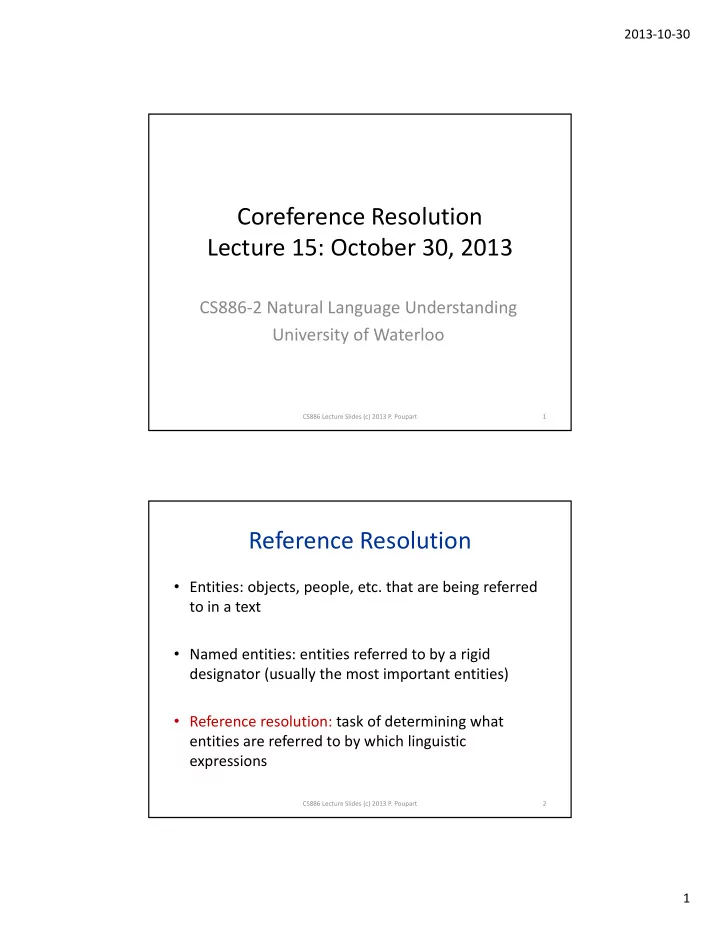

2013 ‐ 10 ‐ 30 Coreference Resolution Lecture 15: October 30, 2013 CS886 ‐ 2 Natural Language Understanding University of Waterloo CS886 Lecture Slides (c) 2013 P. Poupart 1 Reference Resolution • Entities: objects, people, etc. that are being referred to in a text • Named entities: entities referred to by a rigid designator (usually the most important entities) • Reference resolution: task of determining what entities are referred to by which linguistic expressions CS886 Lecture Slides (c) 2013 P. Poupart 2 1
2013 ‐ 10 ‐ 30 Example CS886 Lecture Slides (c) 2013 P. Poupart 3 Coreference • Referring expression (a.k.a. mention): natural language expression used to perform reference – Observed • Referent: entity that is being referred to – Hidden • Coreference: when two referring expressions refer to the same entity CS886 Lecture Slides (c) 2013 P. Poupart 4 2
2013 ‐ 10 ‐ 30 Anaphora • Antecedent: term for a referring expression that licenses the use of another • Reference to an entity that has been previously introduced into the discourse is called anaphora and the referring expression used is said to be anaphoric • Example: John is smart. He solved the problem CS886 Lecture Slides (c) 2013 P. Poupart 5 Coreference Resolution • Coreference resolution: task of finding referring expressions in a text that refer to the same entity. • Pronominal anaphora resolution: task of finding the antecedent for a single pronoun – Subtask of coreference resolution CS886 Lecture Slides (c) 2013 P. Poupart 6 3
2013 ‐ 10 ‐ 30 Two Views • Classification: classify every pair of mentions as coreferent or not – Complexity: quadratic in # of mentions – Challenge: global consistency • Clustering: partition mentions by entities – Global consistency more easily achieved – Challenge: complexity (exponentially many partitions) CS886 Lecture Slides (c) 2013 P. Poupart 7 Referring Expressions (Mentions) • Noun phrases – Indefinite – Definite • Pronouns – Definite – Demonstrative • Names CS886 Lecture Slides (c) 2013 P. Poupart 8 4
2013 ‐ 10 ‐ 30 Indefinite Noun Phrases • Indefinite references introduce entities that are new to the reader – Often marked by “a”, “an”, “some” but may also be marked by “the” • Examples: – Mrs . Martin was so kind as to send Mrs. Goddard a beautiful goose – He had gone around one day to bring her some walnuts – I saw this beautiful Ford Falcon today CS886 Lecture Slides (c) 2013 P. Poupart 9 Definite Noun Phrases • Definite references refer to an entity that is identifiable to the hearer because it has been mentioned previously – An entity may be identifiable even if it was not already mentioned because it is part of the hearer’s set of beliefs • Examples: – It concerns a white stallion which I have sold to an officer, but the pedigree of the white stallion was not fully established – I read about it in the New York Times. CS886 Lecture Slides (c) 2013 P. Poupart 10 5
2013 ‐ 10 ‐ 30 Pronouns • Another form of definite reference is pronominalization – E.g., Emma smiled and chatted as cheerfully as she could. • NB: Pronouns can be used in cataphora, in which they are mentioned before their referents are – E.g. Even before she saw it, Dorothy had been thinking about Emerald City. CS886 Lecture Slides (c) 2013 P. Poupart 11 Demonstrative Pronouns • “this” and “that” are demonstratives that may be used alone or as determiners – This: proximal demonstrative – That: distal demonstrative • Example – I just bought a copy of Thoreau’s Walden. I had bought one five years ago. That one had been very tattered; this one was in much better condition. CS886 Lecture Slides (c) 2013 P. Poupart 12 6
2013 ‐ 10 ‐ 30 Names • Names are a common form of referring expression, including names of people, organizations and locations • Example – International Business Machines sought patent compensation from Amazon; IBM had previously sued other companies. CS886 Lecture Slides (c) 2013 P. Poupart 13 Features • Number agreement • Person agreement • Gender agreement • Binding constraints • Preferences in pronoun interpretation – Recency, grammatical role, repeated mention, parallelism, verb semantics, selectional restrictions CS886 Lecture Slides (c) 2013 P. Poupart 14 7
Recommend
More recommend